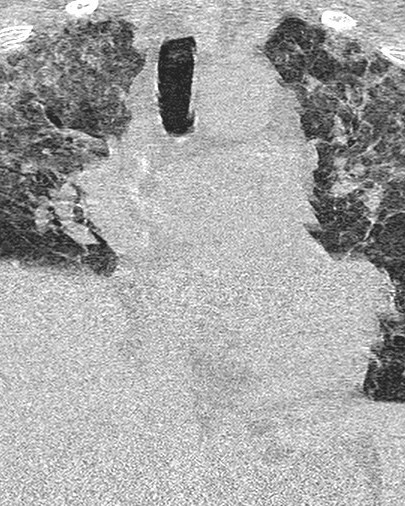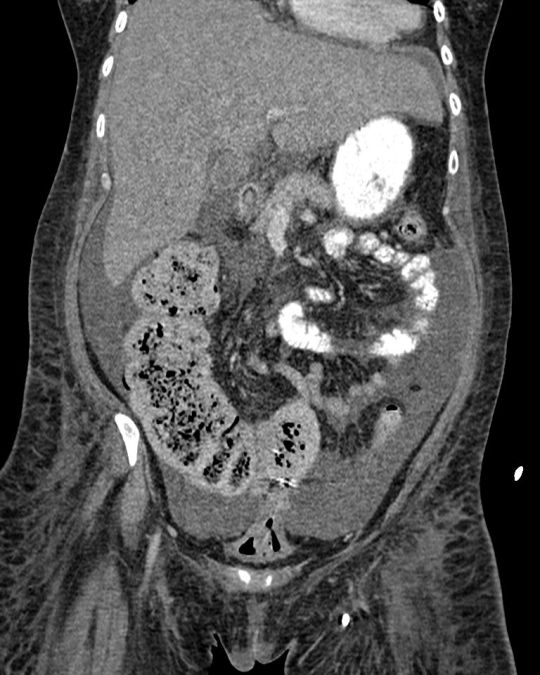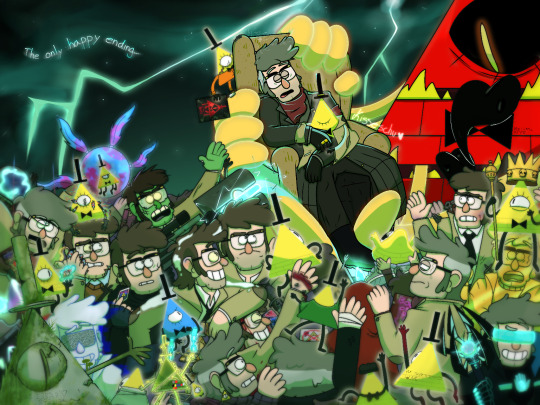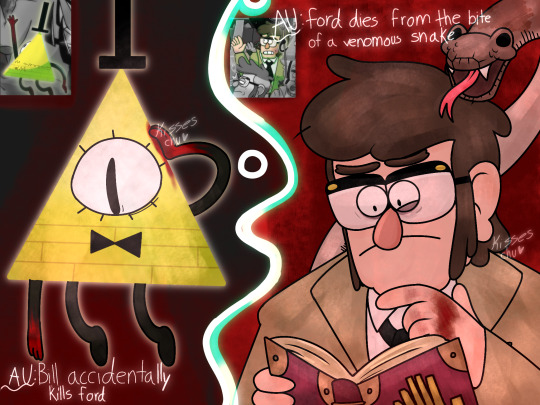#gvhd
Explore tagged Tumblr posts
Text


Stem cell transplantation (SCT) can cause a host of complications. Graft versus host disease (GVHD) is common and can be severe, affecting many organ systems. In acute GVHD, end-organ damage is the result of recipient's APCs interacting with donor T-cells, leading to donor T-cell activation with a resultant cell-mediated and inflammatory cascade. The pathophysiology of chronic GVHD is not well understood. Skin, small intestine, and liver are most commonly affected; lung involvement is less common.
Acute GVHD typically occurs within 100 days post SCT and can cause bowel wall thickening and/or dilatation, biliary abnormalities, ascites, pulmonary edema, diffuse alveolar hemorrhage, and a myriad of other findings. Chronic GVHD typically occurs within 2 years of SCT and may affect skin, mouth, GI tract, liver, lungs, muscles, joints, or genitals. Imaging is based on presenting symptoms.
Read more about the complications of SCT (including GVHD) from the American Cancer Society. https://www.cancer.org/.../transplant-side-effects.html
Today’s case is a patient 2 months post SCT who presented with shortness of breath, nausea, and vomiting. Lungs demonstrate upper lung predominant groundglass opacities and interstitial thickening, worrisome for acute GVHD. The cecum is thickened and enhancing, with pneumatosis, likely indicating typhlitis (neutropenic colitis). There is also moderate volume ascites.
Case courtesy of Hoe Han Guan, Radiopaedia.org, rID: 166522
#TeachingRounds#FOAMEd#FOAMRAd#Radiology#transplant#transplantimaging#transplantmedicine#infectiousdisease#pulmonology#gastroenterology#hematology#GVHD#stemcelltransplant
2 notes
·
View notes
Text
Novel MSC-based therapy provides hope for ocular GVHD treatment
Graft-versus-host disease (GVHD) is a common and severe complication that occurs after stem cell transplantation, where the donor’s immune cells attack the recipient’s tissues. Ocular manifestation of GVHD is among the most challenging to treat, often leading to chronic inflammation and corneal tissue damage, which can result in loss of vision. Conventional treatments, including corticosteroids,…

View On WordPress
0 notes
Text
youtube
#StemCellTransplant#BoneMarrowTransplant#AutologousTransplant#AllogeneicTransplant#SyngeneicTransplant#HematologicCancers#Leukemia#Lymphoma#MultipleMyeloma#PeripheralBloodStemCells#UmbilicalCordBlood#GVHD#ConditioningRegimen#Engraftment#Immunotherapy#AplasticAnemia#SickleCellAnemia#GeneEditing#CAR-TCellTherapy#CordBloodExpansion#Youtube
0 notes
Text
The medical expertise and nursing care here is excellent
I just want to clear up some misunderstandings that may arise from some of my previous posts; the fact that none of the samples from Leah’s lungs have ever grown any bugs is not actually good news – a lung infection in a post transplant patient is potentially easier to treat than inflammation. Inflammation of the lungs is called PNEUMONITIS and I’m told that in Leah’s case it’s likely to be an…
View On WordPress
#Belfast City Hospital#Bristol Children&039;s Hospital#GVHD#ICU#Immune reaction#lack of facilities#medical expertise#nursing care#pneumonitis#post transplant
0 notes
Text
𝗘𝘅𝗽𝗹𝗼𝗿𝗶𝗻𝗴 𝗠𝗮𝗿𝗸𝗲𝘁 𝗜𝗻𝘀𝗶𝗴𝗵𝘁𝘀: Graft-Versus-Host Disease (GvHD): Graft-Versus-Host Disease (GvHD)
Wissen Research presents a comprehensive report on Graft-Versus-Host Disease (GvHD) highlighting:
#Market Insight #Opportunity Analysis #Key Opinion Leader Analysis #Regulatory Analysis #Clinical Trial #Product Analysis (Approved and Pipeline) #Patent Analysis #Scientific Literature Analysis #Market Forecast
📑For detailed report: https://www.wissenresearch.com/graft-versus-host-disease-market-report-2023/ 📑 Request customized study: https://www.wissenresearch.com/ask-for-customization/
1 note
·
View note
Text
How much percentage robot is Simmons even?
I cannot figure it out without thinking abt how that operation is done both functionally and safely
Does anyone know if it was ever mentioned?
#Posting on my art acc bc Im going insane trying to design him!!#rvb#red vs blue#dick simmons#Ive done actual research to see what types of transplantation would seem similar#The GVHD on this one goes CRAZY!!!
18 notes
·
View notes
Text
I choose a simple topic for my 5 minute presentation assignment thinking it'll make the assignment painless. I immediately get frustrated by how little there is to say about it because the topic is simple and straightforward and I feel like I'm not doing good enough research. why am I like this.
#gvhd is so annoyingly straightforward I should've gone with car t regs#except then I'd be complaining about how much I don't like car t cell research and how done I am with t regs#why do i have to do assignments I'm a researcher now don't make me do presentations anymore#AND I have an essay to write and an introduction to my thesis#technically the intro isn't really due yet but my pi will be disappointed more than she already is
0 notes
Text
#Bone Marrow Transplant#Graft Versus Host Disease (#Types of GVHD#Symptoms of GVHD#kauvery hospital#healthcare#healthy#healthcare blog#healthcare news
0 notes
Text
Acute pancreatitis in Thalassemia post allogeneic stem cell transplant with Cyclosporine-A as a possible etiology: A report of two cases by Narendra Agrawal in International Journal of Clinical Images and Medical Reviews
Abstract
Cyclosporine is an important component of GVHD Prophylaxis in Hematopoietic Stem Cell Transplant (HCT). It has narrow therapeutic index and is known to cause hypertension, electrolyte imbalances, Acute Kidney Injury, etc. High suspicion of these adverse effects helps us in managing them effectively. We report here two cases of pediatric age group who presented with acute pancreatitis post matched sibling HCT for Thalassemia transplant. To our knowledge we could find only 2 case reports of Cyclosporine induced pancreatitis post HCT in literature and none reported post HCT in Thalassemia. Diagnosis of acute pancreatitis especially in pediatric age group can be challenging without high suspicion.The purpose of our report is to highlight the importance of keeping acute pancreatitis in differential of unwell child post HCT in Thalassemia and careful rechallenge of Cyclosporine may be possible with careful monitoring, thereby not compromising on GVHD prophylaxis.
Key-words: Pancreatitis, Cyclosporine, Thalassemia, GVHD prophylaxis
Key Messages: This report highlights the importance of suspecting pancreatitis in a paediatric thalassemia patient post allogeneic stem cell transplant with cyclosporine –A as possible causative factor. CSA reintroduction can be attempted with careful monitoring after recovery.
Introduction
Cyclosporine (CsA) is a cyclic polypeptide immunosuppressant agent. It is produced as a metabolite by the fungus species Beauveria nivea1. CsA has been used extensively for immune suppression in allogeneic hematopoietic cell transplantation (alloHCT) as well as solid organ transplants for prevention and treatment of graft versus host disease (GVHD) and graft rejection1. CsA has a narrow therapeutic index and requires therapeutic dose monitoring. Common adverse effects of CsA include nephrotoxicity, HCT, hypertension, and hypomagnesemia1. Acute Pancreatitis has been reported with the use of CsA in organ transplants2.
With an extensive literature search, we could not find any report of CsA induced acute pancreatitis after alloHCT for thalassemia or other hemoglobinopathies. Here we report two pediatric patients with thalassemia major, of CsA induced acute pancreatitis after HLA matched family donor HCT.
Case History
Case 1, a 2-year-old female child with Thalassemia major, presented on day +66 of HLA matched mother donor alloHCT with a history of constipation, irritable behavior, episodes of crying, decreased oral intake and vomiting of 2 days duration. Abdominal examination was remarkable for mild diffuse tenderness and sluggish bowel sounds. X-ray abdomen was suggestive of dilated colon while an USG of abdomen was suggestive of gaseous bowel distension. Pediatric Surgery review suggested a possibility of subacute intestinal obstruction. The patient was treated conservatively by withholding oral foods and fluids (NPO) and application of bisacodyl suppositories. Constipation resolved but she continued to remain irritable with the persistence of abdominal signs. A possibility of acute pancreatitis was considered and serum amylase and lipase were sent which turned out to be 183 IU/L (normal range 22-80) and 2350 IU/L (normal range 23-300). CT Abdomen was notable for modified CT severity index for acute pancreatitis (CTSI) of 43. A careful review of her drugs and history of illness was carried out. She was not found to be suffering from viral prodrome anytime in the previous month. Her serum calcium and triglyceride levels were normal while PCRs for CMV and EBV were negative. She was receiving CsA along with prophylactic acyclovir, penicillin V and co-trimoxazole. Her plasma CsA trough level was 61 ng/mL on the day of her presentation. A possibility of CsA induced acute pancreatitis was considered4. Naranjo algorithm for causation score was 7 for CsA suggesting probable causation5. Her blood pressure and renal functions were normal. She had no other CsA toxicity. With conservative management her symptoms improved over 1 week, USG done after 1 week was suggestive of resolving pancreatitis with falling levels of serum lipase and amylase. She was shifted to Mycophenolate Mofetil (MMF) for GVHD prophylaxis. On day+100 follow up, her chimerism was maintained at 100% donor, but liver enzymes were raised. After excluding infective and drug-induced hepatitis, a possibility of liver GVHD was considered. A decision to re-challenge with CsA under close monitoring was taken. CsA was re-introduced starting at low doses with monitoring of amylase and lipase levels and close monitoring for clinical signs. She did not have a repeat episode of acute pancreatitis and is currently on tapering immunosuppression on day+260 of follow up.
C ase 2, a 4-year-old female child with thalassemia major presented on day+154 of HLA matched sibling donor alloHCT with a history of abdominal pain, vomiting and poor oral intake of 2 days duration. The patient had no history of fever. On examination, the patient had tachyuration. The patient had no history of fever. On examination, the patient had cardia, normal blood pressure for age, abdominal distention with mild diffuse tenderness. Her USG was suggestive of the bulky pancreas, amylase, and lipase levels were 643 IU/L and 4253 IU/L. The plasma CsA trough level was 252ng/mL. Her chimerism test showed 68% of donor cells. A careful review of her clinical history, lab results, and medications couldn’t find other causes of acute pancreatitis than CsA. Naranjo algorithm causation score was 7 for CsA suggesting probable causation5. There were no other CsA toxicities. CsA was stopped and she improved with conservative management. The patient was started on MMF for GVHD prophylaxis thereafter. She was considered for a re-challenge of CsA especially after our experience of successful re-challenge of CSA in our previous patient. She was restarted on CsA starting from low doses with amylase and lipase monitoring from day +185 onwards. Currently, she is on escalating doses of CsA on day +225 of follow up with donor chimerism improved to 76%.
Discussion
Ito, T. et al showed that intravenous injection of CsA 10 and 20mg/kg body weight (BW) in rats increased the content of pancreatic amylase and protein and decreased the content of pancreatic DNA6. Histologically, intraacinar vacuolization and individual cell necrosis were observed6. CsA induced a significant increase in serum amylase and pancreatic wet weight in a dose-dependent manner6. Qi C et al reported acute pancreatitis in a 16-year-old female patient with acute leukemia on day 24 of alloHCT with CsA or Tigecycline as potential causative agents4. In a case report by Guo R et al from China, CsA induced acute pancreatitis was reported on day+20 of HLA matched alloHCT in a 49-year-old male with AML-M27.
Whether Acute pancreatitis developing in post alloHCT patients with relatively lesser duration of exposure to CsA is idiosyncratic or dose-dependent is yet to be elucidated. Although animal experiment data points towards dose-dependent toxicity, in both our cases acute pancreatitis, developed at acceptable plasma levels, questioning this notion.
Other than that, Post-transplant diabetes mellitus (PTDM) is a complication that takes place after solid organ transplant as well as alloHCTs, with reported incidences ranging from 2 to 53%. Cyclosporine is one of the risk factors for developing PTDM probably due to direct toxic effects on beta cells of the pancreas8.
From this experience, we conclude that studies are needed in the pathogenesis of CsA induced acute pancreatitis in post alloHCT patients. High suspicion of acute pancreatitis should be kept in post alloHCT patients with abdominal signs and symptoms especially in pediatric patients who may not be able to communicate the typical pain history. CsA re-challenge didn’t precipitate pancreatitis in our patients.
Declarations
Funding: Funding information is not applicable to this study.
Conflict of Interest: All authors declare no conflict of interest to declare.
Compliance with Ethical Standards
Ethical Approval Statement: All authors stated that the study has been approved by the appropriate institutional review board and have been performed in accordance with the ethical standards as laid down in the 1964 Declaration of Helsinki and its later amendments or comparable ethical standards.
Acknowledgements We would like to acknowledge Dr Rayaz Ahmed, Dr Vishvdeep Khushoo and Dr Pallavi Mehta in treatment of the patients. We thank all the members, and staff of Rajiv Gandhi Cancer Institute and Research Centre, India for their contribution in the conduct of the study
For more details: https://ijcimr.org/editorial-board/
#Pancreatitis#Cyclosporine#Thalassemia#GVHD prophylaxis#HCT#nephrotoxicity#hypertension#NPO#PTDM#Narendra Agrawal#ijcimr
0 notes
Note
So what you want Kate to not get chemotherapy so that she gets even more worse and more unwell? Who even thinks like that and William doesn’t smoke

First off, it's well known that William smokes. Just because he hides it better than Harry doesn't mean he doesn't do it. He clearly has smoker skin. That's why his skin looks so terrible & dry. So dry that soon we might be able to grate cheese on it.
"You want Kate to not get chemotherapy so that she gets even more worse and more unwell?"
Your ignorance is clearly showing.
This is how people die from cancer:
Catabolism: the body breaks down on a cellular level; substances released by tumor cells are strong anorexics.
Secondary infection due to immune system suppression.
Blockage of vital structures: trachea/esophagus, superior vena cava (SVC) syndrome, impacts to the spinal cord, pericardial effusion, pleural effusion, etc.
Side effects of medication/treatment: immune suppression, pulmonary fibrosis, Graft-versus-Host-Disease (GvHD), etc.
You do not die from cancer just because you have "cancer."
I wrote a long post yesterday differentiating that different people have different physiology. Just because you have "cancer" does not mean that it poses a threat to your life or health. Plenty of people have "cancer" that does not progress at all or affect them in any way. Just because you have "cancer present" does not mean it will affect your life or health in any significant way.
The situation is really like the anon said:
"Catherine has a much more serious cancer than they are letting on, hence, the decision to have chemo is not even a discussion point,"
"she’s not having chemo and there’s another reason why she’s missing in action,"
"she and William are panicking and she’s receiving chemo regardless"
My bets are on numbers two or three.
Kensington Palace is clearly lying. Can't wait for it to be revealed! KP's strategy before Kate's cancer announcement was to release the news that her medical records had been breached and paint Kate as a victim. After the cancer announcement, it was those pesky conspiracy theorists and the axis of evil who was to blame for Kate's reputation being slagged around the world, not the utter incompetence of William and KP.
Let's not forget that William is an emotionally damaged, thin skinned, control freak with a privacy fetish.
Let's also not forget that next Monday, 01 April 2024, begins a new fiscal year for the BRF.

#ask#hate mail#medicine#smoking#William The Prince of OWN GOALS#William The Terrible#William The Weak#William The Prince of Wales#prince william#Prince & Princess OWN GOALS#kate middleton#Catherine The Princess of Wales#kensington palace#palace officials#lies lies lies#pr games#strategery#Wales fandom ARMAGEDDON#cancer schmancer
14 notes
·
View notes
Text
Graft Vs Host Disease: Causes, Diagnosis, Treatment, and More

Graft versus host disease (GVHD) is a complex medical condition that can occur after a stem cell or bone marrow transplant. It is characterized by the donor's immune cells attacking the recipient's body, leading to a range of symptoms and complications.
The causes of GVHD are multifactorial, involving the interaction between the donor and recipient immune systems, as well as genetic and environmental factors. Diagnosis of GVHD involves a thorough assessment of the patient's medical history, physical examination, and specialized laboratory tests. For more information on GVHD, visit our website or the below-mentioned source link.
Source: graft vs host disease
8 notes
·
View notes
Text
Can't put this on fb because I don't want to hear people's mouths (mainly family), so I'll vent here instead. I've had cancer 3 times. First, cervical. Next, breast. Now, acute myeloid leukemia. I'm in remission, but what I had to do to get myself here, most people don't survive it. I've done shit tons of chemo. I want to say I've done extensive regiments of chemo 5 times, including several different kinds at the same time. I had a double mastectomy and they took 19 lymph nodes from my armpit. I did radiation for 6 weeks. I've had to do physical therapy twice. I just had a stem cell transplant in Feb. I've had 2 blood infections in 4 months. I've had a port and 2 Hickman lines in my chest. I still have my line today. Every other day, I have to hook up an antifungal to it. I also have to flush it every day. I have to go to the hospital once a week for a follow up. Let me just say, I'm tired of being tired, and I'm sick of being sick. Now, I take 16 different meds 3 times a day. My stomach is always fucked up, and I constantly have diarrhea. I also have GVHD of the skin. My memory is fucked because of all the treatments. Everything I've gone through has completely changed my body. I used to be thin and hot. Now I'm 60 pounds overweight and look pregnant because I don't have tits to hide my massive gut. I never used to look my age, but chemo has aged me drastically. My hair is just now starting to grow back after the transplant. And don't get me started on menopause. Don't get me wrong. I'm grateful and happy to be alive. My son still has his mom, but I'm tired of everything. So very sick and tired. This is why I disappear for months at a time. Because I'm undergoing treatment. I've spent a lot of time in the hospital. Now, every time I smell a hospital smell, it reminds me of the time I almost died. I've almost passed away 4 times now. I didn't need cpr or anything, but I could tell by the way I felt that death was close. Sepsis will do that. Somehow, I survived. I guess it's not my time, and that's okay because I'm not ready yet. I have a child to raise (the best kid ever), and I have the best life partner ever. I also have a cousin who is some kind of angel in disguise. If it wasn't for them, idk what I would do. I probably would have given up. In the last 3 years, I've lost my mom, my aunt, and my uncle to cancer. I was my mom's caretaker and watched her take her last breath. I watched her soul leave her body. We had breast cancer at the same time. I held my aunt's hand and watched her take her last breath. She had a rare intestinal cancer and basically starved to death. I was in the hospital doing chemo when my uncle died. He had esophageal cancer and also starved to death. To say I've had it rough is putting it mildly, but I'm still here fighting. I'm the last one fighting, but I'm still alive. And for that, I'm grateful. Like, I'm a strong person, but please don't throw anything else at me, Spirit. This Druid can't handle anymore.
Peace out. If y'all need me, I'll be in the woods worshipping Mother Nature and stacking cairn stones.
#Personal#Vent post#fuck cancer#Cancer sucks#So frustrated I'm ugly crying#Please don't drop anything else in my lap#Ivy475 vents
3 notes
·
View notes
Text
#SUPPORTSUPPORTSUPPORT #I cherish this deep down in my soul sajhjkcjhvgjecfkdchf gvhd


Are you having trouble following the AU/alternate lines? i've created additional resources that explain and provide credits for each one!
Aus:

MrBillPines: @honeqq
StaticFord: @void-dude

UniversalVirusAu: @kittygirl2210
DosmeticatedFord: @jellyskink

MM!Ford: @orxinus DreamcaptorAu: @neonross

Handyman!Bill: @handymanbill
(#waty_mot #LosanPostle)
Alternate plot lines within the canon(maybe):





Canon character desings:





I spent three months working on this drawing: two months on the first two parts and one month on the extras. It was a real challenge, but I had fun trying to match the original Gravity Falls style. Here's a little behind-the-scenes!
The plan was to post it by the end of December, then by the first two weeks of January, and well... It's already February 3rd. I would have posted it much earlier, I was really eager to share it, but I wanted to add the extra drawings!
Mental note: never do giant drawings again because they lose quality when compressed 😞oh man

i feel so proud <3
Anyways, i'm still learing English, so please tell me if i say something weird or incorrect.
(if it's this, i going to die of shame).
2K notes
·
View notes
Text
No keeping this girl down!
Today Leah is medically more or less in the same place as yesterday. The samples that were taken from her lungs on Thursday and were sent to the laboratory haven’t grown anything, so this confuses the PCP diagnosis a little bit and has led some of the docs to suspect that Leah may have pneumonitis, another complication of transplant. It’s not one I fully understand but I think it could be a…
View On WordPress
0 notes
Text
0 notes